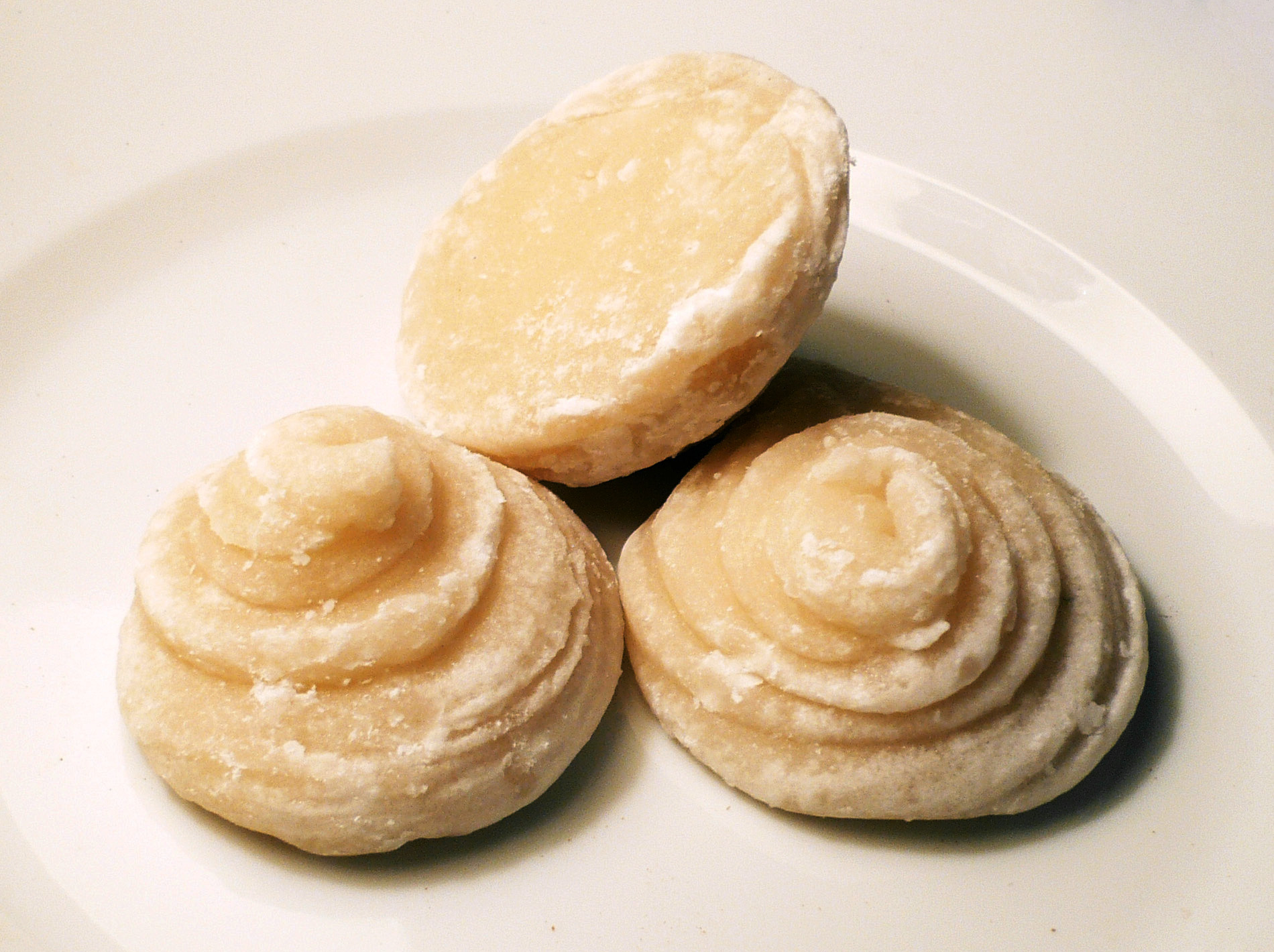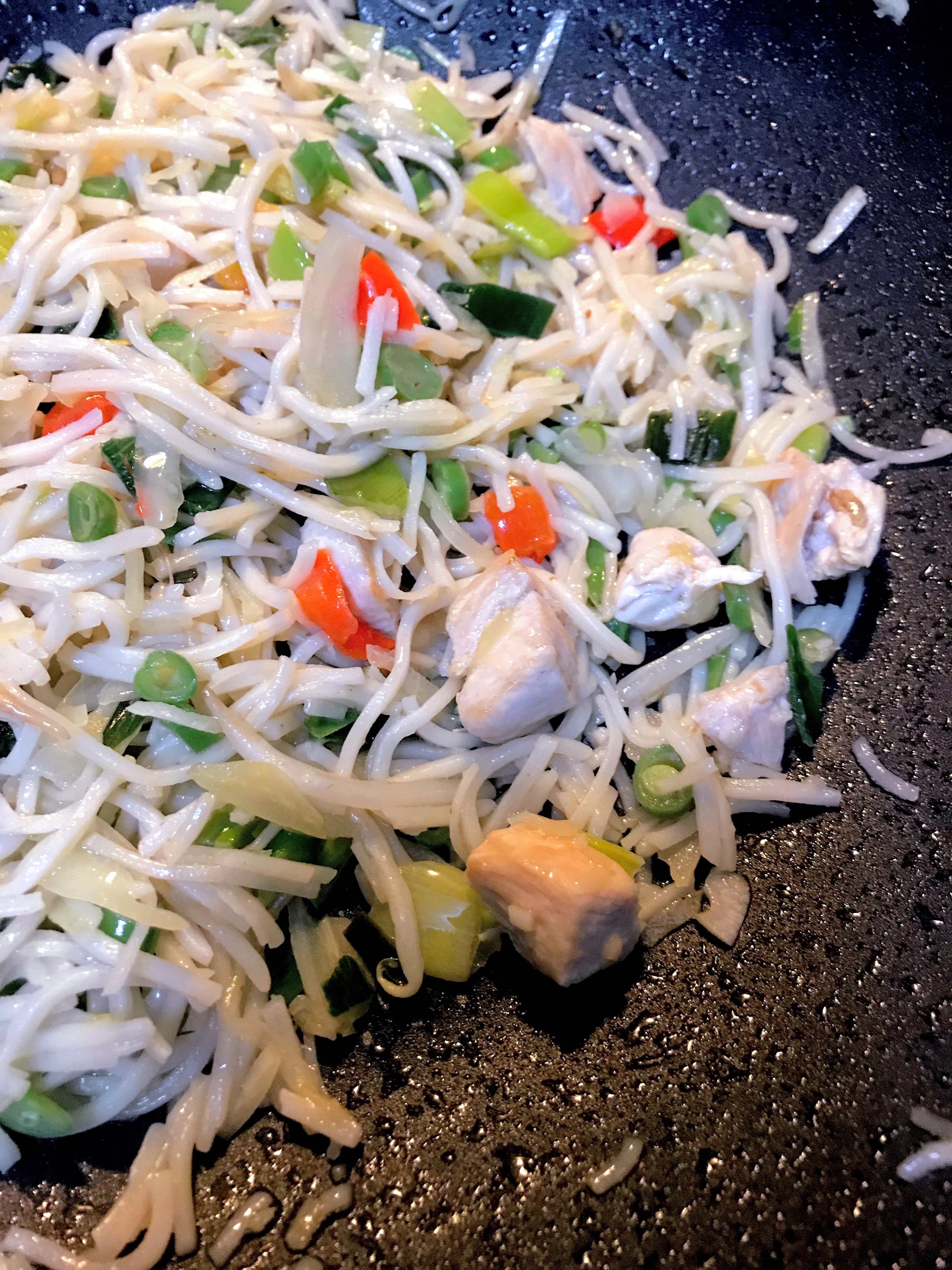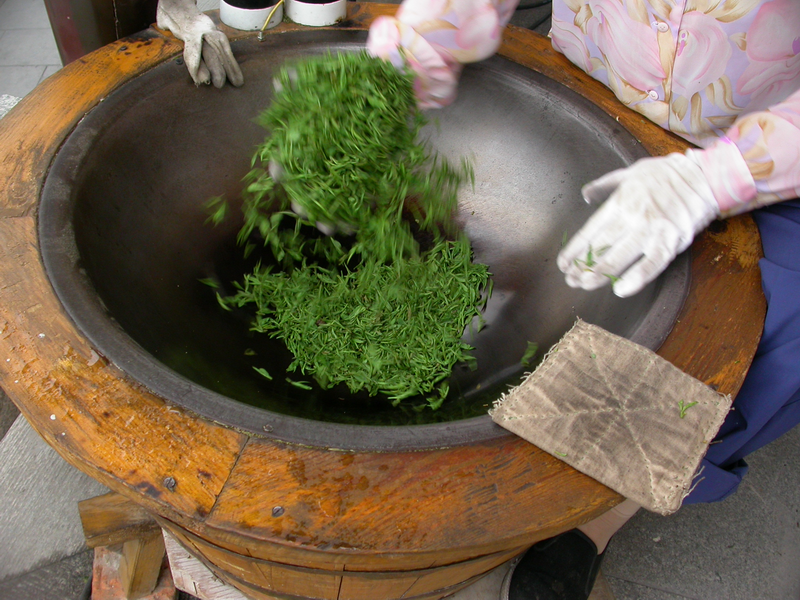|
Pad Thai
Pad thai, phat thai, or phad thai ( or ; th, , , ISO: ''p̄hạd thịy'', , 'Thai stir fry'), is a stir-fried rice noodle dish commonly served as a street food in Thailand as part of the country's cuisine. It is typically made with rice noodles, shrimp, peanuts, a scrambled egg, and bean sprouts, among other vegetables. The ingredients are fried in a wok. Ingredients Pad thai is made with rehydrated dried rice noodles with some tapioca flour mixed in, which are stir fried with eggs and chopped firm tofu, flavored with tamarind juice, fish sauce, dried shrimp, garlic or shallots, red chili pepper and palm sugar, and served with lime wedges and often chopped roasted peanuts. It may contain other vegetables like bean sprouts, garlic chives, pickled radishes or turnips, and raw banana flowers. It may also contain fresh shrimp, crab, squid, chicken or other fish or meat. Many of the ingredients are provided on the side as condiments, such as the red chili pepper, lime wed ... [...More Info...] [...Related Items...] OR: [Wikipedia] [Google] [Baidu] |
Street Stall
A market stall or a booth is a structure used by merchants to display and house their merchandise in a street market, fairs and conventions. Some commercial marketplaces, including market squares or flea markets, may permit more permanent stalls. Stalls are also used throughout the world by vendors selling street food. There are many types of stalls, including carts designed to be pulled by hand or cycles; makeshift structures like tents, or converted tow-caravans and motor vehicle A motor vehicle, also known as motorized vehicle or automotive vehicle, is a self-propelled land vehicle, commonly wheeled, that does not operate on rails (such as trains or trams) and is used for the transportation of people or cargo. The vehi ...s. References {{wiktionarypar, market stall Retail markets Street culture ... [...More Info...] [...Related Items...] OR: [Wikipedia] [Google] [Baidu] |
Chili Pepper
Chili peppers (also chile, chile pepper, chilli pepper, or chilli), from Nahuatl '' chīlli'' (), are varieties of the berry-fruit of plants from the genus ''Capsicum'', which are members of the nightshade family Solanaceae, cultivated for their pungency. Chili peppers are widely used in many cuisines as a spice to add "heat" to dishes. Capsaicin and related compounds known as capsaicinoids are the substances giving chili peppers their intensity when ingested or applied topically. While ''chili peppers'' are (to varying degrees) pungent or "spicy", there are other varieties of capsicum such as bell peppers (UK: peppers) which generally provide additional sweetness and flavor to a meal rather than “heat.” Chili peppers are believed to have originated somewhere in Central or South America. and were first cultivated in Mexico. After the Columbian Exchange, many cultivars of chili pepper spread around the world, used for both food and traditional medicine. This led to ... [...More Info...] [...Related Items...] OR: [Wikipedia] [Google] [Baidu] |
Garlic Chives
''Allium tuberosum'' (garlic chives, Oriental garlic, Asian chives, Chinese chives, Chinese leek) is a species of plant native to the Chinese province of Shanxi, and cultivated and naturalized elsewhere in Asia and around the world. Description ''Allium tuberosum'' is a rhizomatous, clump-forming perennial plant growing from a small, elongated bulb (about , across) that is tough and fibrous. Unlike either onion or garlic, it has strap-shaped leaves with triangular bases, about wide. It produces many white flowers in a round cluster (umbel) on stalks tall. It grows in slowly expanding perennial clumps, but also readily sprouts from seed. In warmer areas (USDA zone 8 and warmer), garlic chives may remain green all year round. In cold areas (USDA zones 7 to 4b), leaves and stalks completely die back to the ground, and resprout from roots or rhizomes in the spring. The flavor is more like garlic than chives. Taxonomy Originally described by Johan Peter Rottler, the species ... [...More Info...] [...Related Items...] OR: [Wikipedia] [Google] [Baidu] |
Mung Bean Sprout
Mung bean sprouts are a culinary vegetable grown by sprouting mung beans. They can be grown by placing and watering the sprouted beans in the shade until the hypocotyls grow long. Mung bean sprouts are extensively cultivated and consumed in East and Southeast Asia and are very easy to grow, requiring minimal care other than a steady supply of water. They are often used in school science projects. Cultivation A variety of techniques are used for sprouting mung beans. A common technique for home growers is sprouting the beans in a jar, with a fine mesh or muslin cloth tied over the top with a rubber band or string. Fresh water is then poured into the jar three to four times a day; the jars are then upturned and left to drain. The precise growing technique to use depends on the amount that one wants to collect. The main principles are: selecting good seed (new and uniform), ensuring that light reaches the seeds, and also ensuring they receive enough humidity while avoiding waterl ... [...More Info...] [...Related Items...] OR: [Wikipedia] [Google] [Baidu] |
Lime (fruit)
A lime (from French ''lime'', from Arabic ''līma'', from Persian ''līmū'', "lemon") is a citrus fruit, which is typically round, green in color, in diameter, and contains acidic juice vesicles. There are several species of citrus trees whose fruits are called limes, including the Key lime (''Citrus aurantiifolia''), Persian lime, Makrut lime, and desert lime. Limes are a rich source of vitamin C, are sour, and are often used to accent the flavours of foods and beverages. They are grown year-round. Plants with fruit called "limes" have diverse genetic origins; limes do not form a monophyletic group. Plants known as "lime" The difficulty in identifying exactly which species of fruit are called lime in different parts of the English-speaking world (and the same problem applies to synonyms in other European languages) is increased by the botanical complexity of the citrus genus itself, to which the majority of limes belong. Species of this genus hybridise readily, and it ... [...More Info...] [...Related Items...] OR: [Wikipedia] [Google] [Baidu] |
Palm Sugar
Palm sugar is a sweetener derived from any variety of palm tree. Palm sugar is sometimes qualified by the type of palm, as in coconut palm sugar. While sugars from different palms may have slightly different compositions, all are processed similarly and can be used interchangeably. Types The predominant sources of palm sugar are the Palmyra, date, nipa, sugar and coconut palms. The Palmyra palm (''Borassus'' spp.) is grown in Africa, Asia, and New Guinea. The tree has many uses, such as thatching, hatmaking, timber, use as a writing material, and in food products. Palm sugar is produced from sap ('toddy') from the flowers. The date palm has two species, ''Phoenix dactylifera'' and '' P. sylvestris'', and both are sources of palm sugar. ''P. dactylifera'' is common in the Mediterranean and Middle East. ''P. sylvestris'' is native to Asia, mainly Pakistan and India. Date palms are cultivated mainly for dates. Palm sugar is made from the tree's sap. The nipa palm ( ... [...More Info...] [...Related Items...] OR: [Wikipedia] [Google] [Baidu] |
Egg (food)
Humans and human ancestors have scavenged and eaten animal eggs for millions of years. Humans in Southeast Asia had domesticated chickens and harvested their eggs for food by 1,500 BCE. The most widely consumed eggs are those of fowl, especially chickens. Eggs of other birds, including ostriches and other ratites, are eaten regularly but much less commonly than those of chickens. People may also eat the eggs of reptiles, amphibians, and fish. Fish eggs consumed as food are known as roe or caviar. Bird and reptile eggs consist of a protective eggshell, albumen ( egg white), and vitellus ( egg yolk), contained within various thin membranes. Egg yolks and whole eggs store significant amounts of protein and choline, and are widely used in cookery. Due to their protein content, the United States Department of Agriculture formerly categorized eggs as ''Meats'' within the Food Guide Pyramid (now MyPlate). Despite the nutritional value of eggs, there are some potential healt ... [...More Info...] [...Related Items...] OR: [Wikipedia] [Google] [Baidu] |
Stir Fried
Stir frying () is a cooking technique in which ingredients are fried in a small amount of very hot oil while being stirred or tossed in a wok. The technique originated in China and in recent centuries has spread into other parts of Asia and the West. It is similar to sautéing in Western cooking technique. Scholars think that wok (or pan) frying may have been used as early as the Han dynasty (206 B.C. – 220 A.D.) for drying grain, not for cooking, but it was not until the Ming dynasty (1368–1644) that the wok reached its modern shape and allowed quick cooking in hot oil. Well into the 20th century, while only restaurants and affluent families could afford the oil and fuel needed for stir fry, the most widely used cooking techniques remained boiling and steaming. Stir fry cooking came to predominate over the course of the century as more people could afford oil and fuel, and in the West spread beyond Chinese communities. Stir frying and Chinese food have been recomme ... [...More Info...] [...Related Items...] OR: [Wikipedia] [Google] [Baidu] |
Rice Noodles
Rice noodles, or simply rice noodle, are noodles made with rice flour and water as the principal ingredients. Sometimes ingredients such as tapioca or corn starch are added in order to improve the transparency or increase the gelatinous and chewy texture of the noodles. Rice noodles are most common in the cuisines of East and Southeast Asia. They are available fresh, frozen, or dried, in various shapes, thicknesses and textures. Fresh noodles are also highly perishable; their shelf life may be just several days. History The origin of rice noodles dates back to China during the Qin dynasty when people from northern China invaded the south. Due to climatic conditions, the northern Chinese have traditionally preferred wheat and millet which grew in cold weather while the southern Chinese preferred rice which grew in hot weather. Noodles are traditionally made out of wheat and eaten throughout northern China so to adapt, northern cooks tried to prepare "noodles" using rice, thus ... [...More Info...] [...Related Items...] OR: [Wikipedia] [Google] [Baidu] |
Street Food
Street food is ready-to-eat food or drinks sold by a hawker, or vendor, in a street or at other public places, such as markets or fairs. It is often sold from a portable food booth, food cart, or food truck and is meant for immediate consumption. Some street foods are regional, but many have spread beyond their regions of origin. Most street foods are classified as both finger food and fast food, and are typically cheaper than restaurant meals. The types of street food widely vary between regions and cultures in different countries around the world. According to a 2007 study from the Food and Agriculture Organization, 2.5 billion people eat street food every day. A majority of middle-income consumers rely on the quick access and cheap service of street food for daily nutrition and job opportunities, especially in developing countries. Today, governments and other organizations are increasingly concerned with both the socioeconomic importance of street food, and with its ass ... [...More Info...] [...Related Items...] OR: [Wikipedia] [Google] [Baidu] |
Rice Noodle
Rice is the seed of the grass species ''Oryza sativa'' (Asian rice) or less commonly '' Oryza glaberrima'' (African rice). The name wild rice is usually used for species of the genera '' Zizania'' and '' Porteresia'', both wild and domesticated, although the term may also be used for primitive or uncultivated varieties of '' Oryza''. As a cereal grain, domesticated rice is the most widely consumed staple food for over half of the world's human population,Abstract, "Rice feeds more than half the world's population." especially in Asia and Africa. It is the agricultural commodity with the third-highest worldwide production, after sugarcane and maize. Since sizable portions of sugarcane and maize crops are used for purposes other than human consumption, rice is the most important food crop with regard to human nutrition and caloric intake, providing more than one-fifth of the calories consumed worldwide by humans. There are many varieties of rice and culinary preferences tend ... [...More Info...] [...Related Items...] OR: [Wikipedia] [Google] [Baidu] |
Stir Frying
Stir frying () is a cooking technique in which ingredients are fried in a small amount of very hot oil while being stirred or tossed in a wok. The technique originated in China and in recent centuries has spread into other parts of Asia and the West. It is similar to sautéing in Western cooking technique. Scholars think that wok (or pan) frying may have been used as early as the Han dynasty (206 B.C. – 220 A.D.) for drying grain, not for cooking, but it was not until the Ming dynasty (1368–1644) that the wok reached its modern shape and allowed quick cooking in hot oil. Well into the 20th century, while only restaurants and affluent families could afford the oil and fuel needed for stir fry, the most widely used cooking techniques remained boiling and steaming. Stir fry cooking came to predominate over the course of the century as more people could afford oil and fuel, and in the West spread beyond Chinese communities. Stir frying and Chinese food have been recomme ... [...More Info...] [...Related Items...] OR: [Wikipedia] [Google] [Baidu] |


.jpg)







